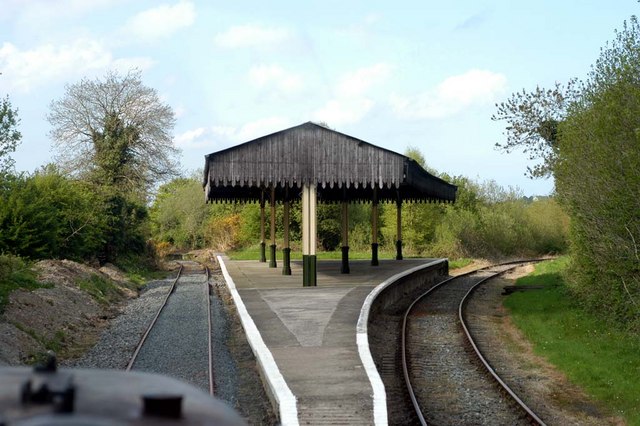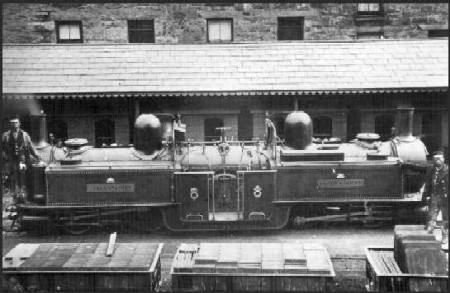|
LPHC No.3 R.H. Smyth
Londonderry Port and Harbour Commissioners (LPHC) No. 3 ''R H Smyth'' is a preserved Irish steam locomotive. Built by Avonside Engineering Company of Bristol, England works No. 2021 in 1928. A fairly typical built to the Irish broad gauge, it led a rather uneventful life shunting the dual gauge (5 ft 3 in and 3 ft) docks in Derry on the west bank of the River Foyle in Northern Ireland. It was equipped with a single off-centre buffer and coupling at each end for shunting gauge stock, in addition to conventional buffers and drawhooks for 5 ft 3 in gauge. After withdrawal, it was bought privately in 1968 before being sold for £1 to the Railway Preservation Society of Ireland at Whitehead in 1972. The engine then acquired the nickname 'Harvey' in honour of showjumper Harvey Smith. In 2000, 30 years after the end of mainline steam in Northern Ireland, No. 3 achieved something of a celebrity status when it was hired by Henry Boot Ltd to help ... [...More Info...] [...Related Items...] OR: [Wikipedia] [Google] [Baidu] |
Jordanstown Railway Station
Jordanstown railway station serves Jordanstown and the University of Ulster in Newtownabbey Newtownabbey ( ) is a large settlement in North Belfast in County Antrim, Northern Ireland. It is separated from the rest of the city by Cavehill and Fortwilliam golf course. It surrounds Carnmoney Hill, and was formed from the merging of severa ..., Northern Ireland. A park and ride facility for the station has been proposed to ease congestion on the main Jordanstown Road. The station was opened on 1 February 1853. The station buildings were demolished in the 1980s and replaced by modest shelters. Prior to this, the station was staffed permanently and had a manually operated level crossing. Today, the level crossing is automatic, and the station is only staffed on the Belfast-bound platform at peak times. Service On Mondays to Fridays, there is a half-hourly service to with extra trains at peak times. In the other direction, there is a half-hourly service with the terminus alternat ... [...More Info...] [...Related Items...] OR: [Wikipedia] [Google] [Baidu] |
Harvey Smith (equestrian)
Harvey John Smith (born 29 December 1938) is a former British show jumping champion. Smith was born in the West Riding of Yorkshire, and still maintains his stables at Craiglands Farm, High Eldwick, Bingley, near Bradford. He stood out from the ranks of showjumpers because of his broad accent and blunt manner. His career was often controversial: in 1971 he was disciplined (overturned on appeal) after he gave a "V sign" to the judges following a near-perfect round which won him the British Show Jumping Derby for the second year in succession; this act also earned him a 'tongue-in-cheek' part in an advert for Victory V sweets with the slogan 'They've got a kick like a mule!' The expression "Doing a Harvey Smith" entered the English language for giving a V sign. Smith became so famous that he embarked on a brief, but unsuccessful, singing career. In 1975 he released a record with picture sleeve called ''True Love/End of the World'' on Handkerchief HANKY 3. The record failed to ... [...More Info...] [...Related Items...] OR: [Wikipedia] [Google] [Baidu] |
Avonside Locomotives
Avonside is an eastern suburb in Christchurch, New Zealand. It is one of the oldest suburbs of the city, with only Heathcote Valley, Heathcote being older. History The suburb was named after Holy Trinity Avonside, which was built beside the Avon River (Canterbury), Avon River in 1855. The 1874 part of the church was designed by the eminent architect Benjamin Mountfort who is buried in the churchyard. The church was damaged in the 2010 Canterbury earthquake and whilst under repair, was damaged beyond repair in the February 2011 Christchurch earthquake and demolished later that year. Avonside is home to Avonside Girls' High School. It also has the Avon River flowing through it. The boundaries of the original Anglican parish of Avonside were fixed in 1859 and covered much of what is now suburbs such as Aranui, Burwood, New Zealand, Burwood, Linwood, New Zealand, Linwood, Marshland, New Zealand, Marshland, New Brighton, New Zealand, New Brighton, North New Brighton, Parklands, ... [...More Info...] [...Related Items...] OR: [Wikipedia] [Google] [Baidu] |
Steam Locomotives Of Northern Ireland
Steam is a substance containing water in the gas phase, and sometimes also an aerosol of liquid water droplets, or air. This may occur due to evaporation or due to boiling, where heat is applied until water reaches the enthalpy of vaporization. Steam that is saturated or superheated is invisible; however, "steam" often refers to wet steam, the visible mist or aerosol of water droplets formed as water vapor condenses. Water increases in volume by 1,700 times at standard temperature and pressure; this change in volume can be converted into mechanical work by steam engines such as reciprocating piston type engines and steam turbines, which are a sub-group of steam engines. Piston type steam engines played a central role in the Industrial Revolution and modern steam turbines are used to generate more than 80% of the world's electricity. If liquid water comes in contact with a very hot surface or depressurizes quickly below its vapor pressure, it can create a steam explosion. Types ... [...More Info...] [...Related Items...] OR: [Wikipedia] [Google] [Baidu] |
Individual Locomotives Of Ireland
An individual is that which exists as a distinct entity. Individuality (or self-hood) is the state or quality of being an individual; particularly (in the case of humans) of being a person unique from other people and possessing one's own needs or goals, rights and responsibilities. The concept of an individual features in diverse fields, including biology, law, and philosophy. Etymology From the 15th century and earlier (and also today within the fields of statistics and metaphysics) ''individual'' meant " indivisible", typically describing any numerically singular thing, but sometimes meaning "a person". From the 17th century on, ''individual'' has indicated separateness, as in individualism. Law Although individuality and individualism are commonly considered to mature with age/time and experience/wealth, a sane adult human being is usually considered by the state as an "individual person" in law, even if the person denies individual culpability ("I followed instr ... [...More Info...] [...Related Items...] OR: [Wikipedia] [Google] [Baidu] |
Downpatrick And County Down Railway
The Downpatrick and County Down Railway (DCDR) is a five-foot, three-inch (1,600 mm) gauge heritage railway in County Down, Northern Ireland. It is operated by volunteers and runs passenger trains using steam and diesel locomotives, diesel railcars, and vintage carriages. The railway has approximately three miles (4.8 km) of track in a triangular-shaped layout, which connects the town of Downpatrick with the historical sites of Inch Abbey to the north and King Magnus’ Grave to the south. It also houses a museum of railway artefacts and rolling stock originating from both Northern Ireland and the Republic of Ireland, dating from the 1860s to the 1980s. The DCDR’s development was spearheaded by a group of local railway enthusiasts in the early 1980s, and work started on building the railway in 1985. Most of its track is on part of the now-closed Belfast and County Down Railway (BCDR) mainline which ran between Belfast, Downpatrick, and Newcastle. The heritage ra ... [...More Info...] [...Related Items...] OR: [Wikipedia] [Google] [Baidu] |
Whitehead, County Antrim
Whitehead is a small seaside village on the east coast of County Antrim, Northern Ireland, lying almost midway between the towns of Carrickfergus and Larne. It lies within the civil parish of Templecorran, the historic barony of Belfast Lower, and is part of Mid and East Antrim Borough Council. Before the Plantation of Ulster its name was recorded as both Whitehead and Kinbaine (). Located at the base of Muldersleigh Hill, Whitehead lies in a small bay between the limestone cliffs of Whitehead and the black volcanic cliff of Blackhead, with the Blackhead Lighthouse on top, marking the entrance to the Belfast Lough. Whitehead is about from Belfast. On the opposite coast of Belfast Lough, the Copeland Islands, Bangor and part of the County Down coastline, are clearly visible. It had a population of 3,802 in the 2011 Census. Whitehead sometimes known as 'The Town With No Streets', as there are no roadways with the suffix "Street" in their name. History In late Victorian an ... [...More Info...] [...Related Items...] OR: [Wikipedia] [Google] [Baidu] |
Avonside Engine Company
The Avonside Engine Company was a locomotive manufacturer in Avon Street, St. Philip's, Bristol, England between 1864 and 1934. However the business originated with an earlier enterprise Henry Stothert and Company. Origins The firm was originally started by Henry Stothert in 1837 as Henry Stothert and Company. Henry was the son of George Stothert (senior), founder of the nearby Bath engineering firm of Stothert & Pitt. Henry's brother, also named George, was manager of the same firm. The company was given an order for two broad gauge () Firefly class express passenger engines ''Arrow'' and ''Dart'', with driving wheels, delivered for the opening of the Great Western Railway (GWR) from Bristol to Bath on 31 August 1840. This was soon followed by an order for eight smaller Sun class engines with driving wheels. Stothert, Slaughter and Company Edward Slaughter joined the company in 1841, when it became known as Stothert, Slaughter and Company. By 1844 their works were n ... [...More Info...] [...Related Items...] OR: [Wikipedia] [Google] [Baidu] |
.jpg)




